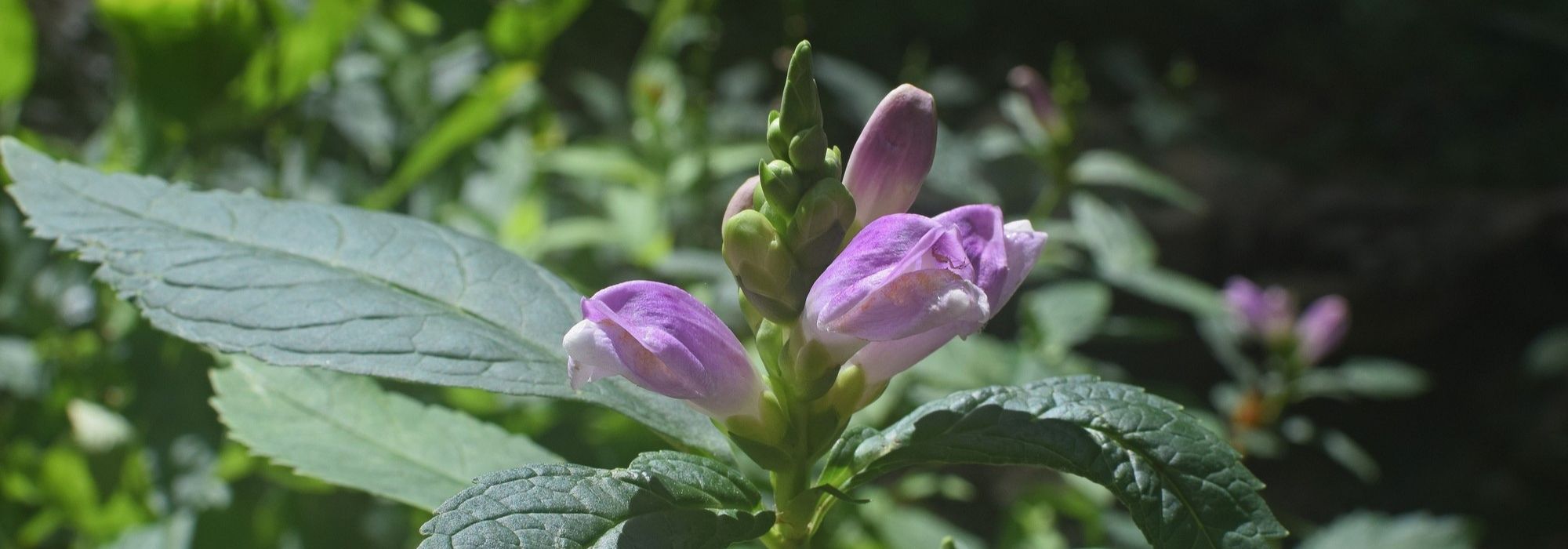
Turtlehead, Purple Chelone: planting, growing
Contents
Turtlehead or Chelone in a nutshell
- Turtlehead or Chelone is a robust perennial of fresh to moist soil
- From summer to autumn it offers superb flowering in bright pink or white spikes
- Grow it equally in sun or shade wherever soil stays consistently cool
- Its ample, vigorous foliage remains elegant until autumn
- Very hardy and easy to grow, it is ideal at edges of water features, in cool borders or in a natural garden
A word from our expert
Chelone, galane or “turtlehead galane” is a beautiful perennial plant very close to Pentstemons, still too little grown in our gardens. Robust and easy to grow, it is one of those perennials that dress borders in summer and into autumn, without requiring much effort from the gardener.
Among the six species composing the genus, the one most commonly cultivated is Chelone obliqua or oblique galane, whose flowering is most often pink; sometimes Chelone glabra with white flowers or Chelone lyonii, the largest of the galanes. Chelone obliqua is available in a few white-flowered varieties, such as Chelone obliqua var. ‘Alba’.
All display dense flower spikes on glossy, deep green foliage.
With romantic colours and low maintenance, it colonises pond margins, wet areas, sunny beds and borders as well as shady corners of the garden, forming colourful, floriferous drifts until early autumn.
Perennial that loves fresh to moist soils, but also tolerates any good garden soil provided it is not too dry in summer, galane is very hardy, rarely troubled by disease and deserves its place in natural, wild gardens or romantic gardens where it can be paired with asters, geraniums or coreopsis.
Discover this beautiful, trouble-free perennial, indispensable in fresh, moist soils!
Description and botany
Botanical data
- Latin name Chelone
- Family Scrophulariaceae
- Common name Turtlehead, oblique turtlehead,red turtlehead, purple chelone
- Flowering July to October
- Height 60 to 80 cm
- Exposure Sun, part-shade
- Soil type fresh to moist
- Hardiness down to -20°C
Turtlehead or Chelone is an herbaceous perennial belonging to family Scrophulariaceae like penstemon, to which it is very closely related. It originates from temperate areas of the United States where it grows naturally on stream banks, in woods and moist meadows or in marshy zones. The genus includes six species of perennials including Chelone glabra, Chelone lyonii, very tall (80 cm) and above all Chelone obliqua, oblique turtlehead with pink flowering, which is the species most commonly found in gardens. This species is considered endangered in its natural habitat. It is available in a few varieties, with white flowers such as Chelone obliqua var. ‘Alba’ or smaller forms such as Chelone obliqua ‘Tiny Tortuga’.
With fairly rapid development, it forms from a powerful, fibrous and taprooting rhizomatous stump a bushy clump with an upright habit rising to about 60–80 cm in height. Oblique turtlehead will reach adult size within two years of cultivation.
Straight stems of fairly rounded section bear a dense deciduous foliage made up of large pairs of triangular to oblong leaves with coarsely dentate margins and marked veins. Their shape strongly resembles that of white nettle. Carried on a very short petiole, leaves measure 5 to 20 cm long and display a fresh to deep glossy green.
This abundant foliage, remaining attractive until autumn, provides a luxuriant green setting for long flowering which begins in August and lasts until first frosts. At stem tips, short, erect, very dense spikes of slightly oblique flowers appear, contrasting with the foliage.
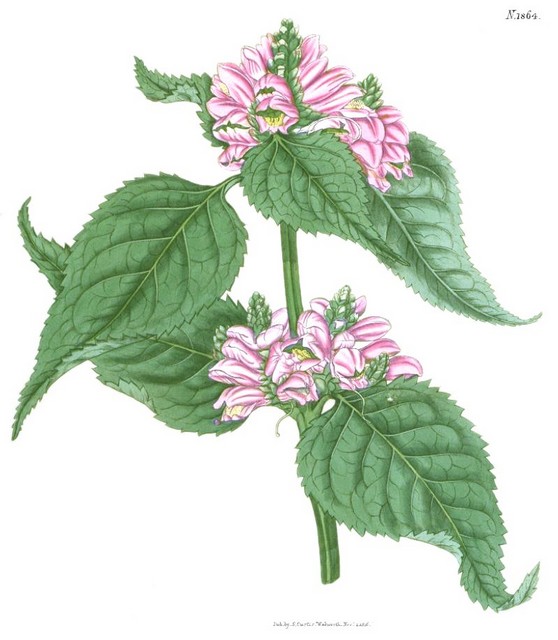
Chelone lyonii (syn. Chelone major) – botanical illustration
Flowers 1–2 cm long are formed of two lips, the upper being in the shape of a blunt galea, resembling, on the botanical side, small foxgloves and, on the animal side, a tortoise’s mouth — hence plant’s nickname “turtlehead”.
These bilabiate corollas set into 5-lobed calyces bear a yellow or white beard and are heightened by a cluster of unequal stamens. These sumptuous small flowers often display hues most frequently purplish-pink or sometimes pure white washed with pale lilac in Chelone obliqua ‘Alba’ or Chelone glabra. They are long-lasting.
These flower clusters turn into small fruits persistent into winter, two-locular capsules containing tiny winged seeds.
Perfectly hardy down to -25 to -30°C, oblique turtlehead can be planted throughout France, except perhaps in regions that are too hot and dry in summer. Undemanding as to exposure, it grows equally well in sun or in part-shade, avoiding scorching situations. It adapts to all fresh to moist soils.
Ideal plant in fresh borders and on banks of a water feature.
Read also
12 perennials for heavy, wet soilMain species and varieties
Most popular
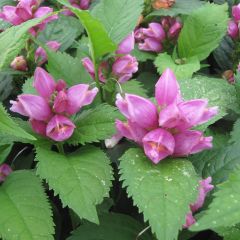
Chelone obliqua
- Flowering time September, October
- Height at maturity 60 cm
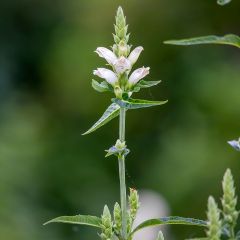
Chelone glabra
- Flowering time September to November
- Height at maturity 60 cm
Our favourites
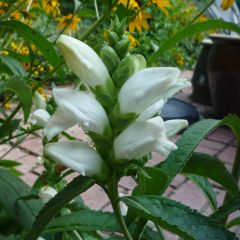
Chelone obliqua Alba
- Flowering time September to November
- Height at maturity 60 cm
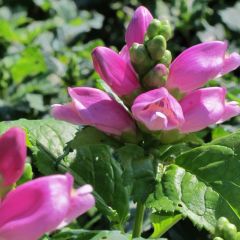
Chelone lyonii Hot Lips
- Flowering time August to October
- Height at maturity 80 cm
Discover other Chelone
View all →Available in 0 sizes
Available in 1 sizes
Available in 2 sizes
Available in 1 sizes
Available in 1 sizes
Planting
Where to plant oblique turtlehead or Chelone?
Oblique turtlehead or Chelone is an undemanding perennial that acclimatises to all gardens except the driest, much hardier than Penstemon to wet cold and negative temperatures down to at least -20°C (sometimes -30°C).
It will tolerate non-scorching sun, dappled shade and even deep shade (flowering will be less generous), as it is indifferent to exposure provided soil remains cool, even moist in season.
Although it adapts to all soils except very poor, dry or stony ground, it prefers deep, rich, humus-bearing, loamy soil that retains permanent moisture. Preference is for woodland soil, neutral or slightly acidic. It is particularly at ease in heavy, clay soils and makes an excellent waterside plant. Cool soil allows vigorous growth.
Ideal plant for planting in light understorey or at pond edge, where it will brighten surroundings with its luminous flowering. It provides a gauzy presence in foreground or middle of a border and in edges that are not too dry. Also perfect for bringing colour and light to a dark corner of garden.
When to plant oblique turtlehead or Chelone?
Planting of oblique turtlehead is carried out in spring from February to April or in autumn from September to November, avoiding periods of severe frost and drought.
How to plant oblique turtlehead or Chelone?
In open ground
Prefer planting in small groups of 5 plants per m², spaced at least 30 to 50 cm apart.
- Fork over soil well
- Dig a hole 2 to 3 times wider than rootball
- Amend with leaf mould and well-rotted compost
- Place rootball and backfill with soil
- Firm soil then water copiously until established
- Mulch base to keep soil cool
And find our tips on planting a perennial properly!
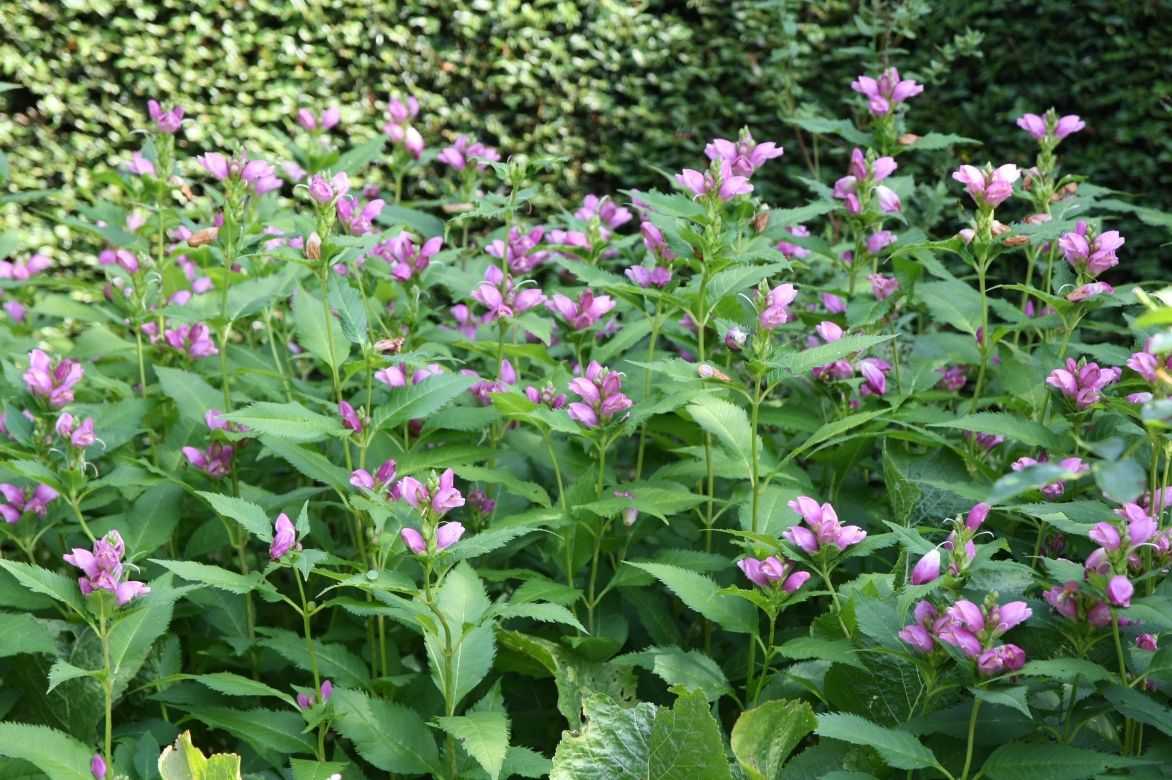
Care and maintenance
Hardy and vigorous, Chelone obliqua requires almost no care and will be unfailingly generous provided soil remains cool and sufficiently nourishing.
Must never be short of water, Chelone obliqua is a perennial that quickly withers in drought: mulch the base from June with a good layer of dry straw or turf to retain freshness and water daily during hot spells.
It prefers rich soils: fertilise each spring with well‑rotted compost.
Chelone does not require pruning. Cut back the plant after flowering if you prefer to prevent self‑seeding, otherwise collect the seeds for future sowings and, in spring, cut back old foliage to encourage new leaf shoots.
Every three years in spring when the plant is well established, divide the largest stumps to rejuvenate the plant and preserve abundant flowering.
Chelone obliqua is a robust plant that knows no disease. Its young shoots are only threatened by slugs and snails at the start of growth. In winter the plant disappears completely: mark its position if necessary to make gastropod control easier in spring. Protect it from their appetite with our 7 ways to fight slugs effectively and naturally.
Propagation: sowing, division
To propagate turtlehead or Chelone obliqua, two options: sowing or dividing clumps in spring.
Dividing clumps of turtlehead
- With a fork-spade, lift part of the stump before growth reappears
- With a spade, cut a good clump with roots
- Replant immediately in the garden in well-worked soil
By sowing
- Harvest Chelone seeds at ripeness and sow them in March–April in a seed tray on the surface of good, well-draining seed compost
- Cover seeds lightly with compost
- Keep slightly moist, warm (20°C) and in light during germination, which takes about 8 weeks
- Place under cover
- Prick out seedlings into individual buckets
Discover our advice and tips to succeed at sowing seeds on our blog !
Companion planting with Chelone
Chelone obliqua or oblique chelone is one of those perennials ideal for brightening cool areas in all natural gardens and on banks and shores of water features in marsh gardens. Following summer flowering, it takes over to create natural, colourful scenes in a simple moist border or bed.
It pairs easily with many late-flowering perennials and creates magnificent compositions in early autumn.
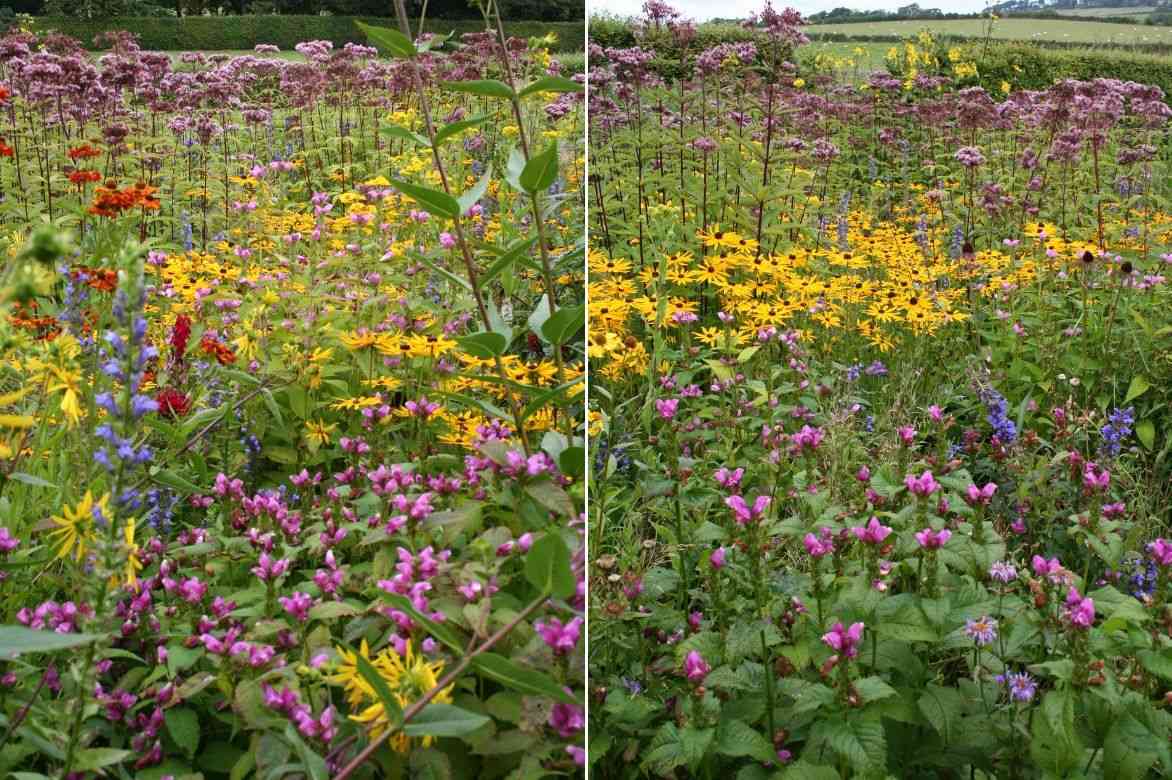
An example of a natural pairing: Chelone obliqua, Rudbeckia (‘Goldsturm’, ‘Henry Eilers’ for example), Nepeta subsessilis, Helianthus, Helenium, Eupatorium…
It will quickly become indispensable in a pink or white garden, alongside Japanese anemones, coreopsis and asters that will accompany its flowering through to autumn.
As it appreciates cool conditions, do not hesitate to plant Chelone on the edge of a pond where it will naturally associate with perennials for wet banks, such as Astilbes, water irises, Barbes-de-bouc, rodgersias, Meadowsweet (Filipendula), lysimachias, persicarias, loosestrifes, osmundas, eupatoriums, or an Euphorbia palustris…
In a wild-style garden at the edge or centre of a border, Chelone’s dense spikes will blend easily with cool tones of geraniums, lobelias and rudbeckias. It will also form a very successful partnership with large grasses such as Miscanthus, Panicum and Stipa.
At edge of a romantic border, chic and cool, plant it at the base of shrub roses or alongside the broad foliage of Hostas for a pleasing contrast of shapes and colours.
To keep soil cool at its base, consider groundcover perennials such as sweet woodruff, seaside wormwood, Japanese ferns, heucheras and creeping bugles.
Useful resources
- Our selection of perennials for fresh to wet soils is outstanding — why not treat yourself!
- How to mess up planting your perennials in 6 lessons?
- Subscribe!
- Contents
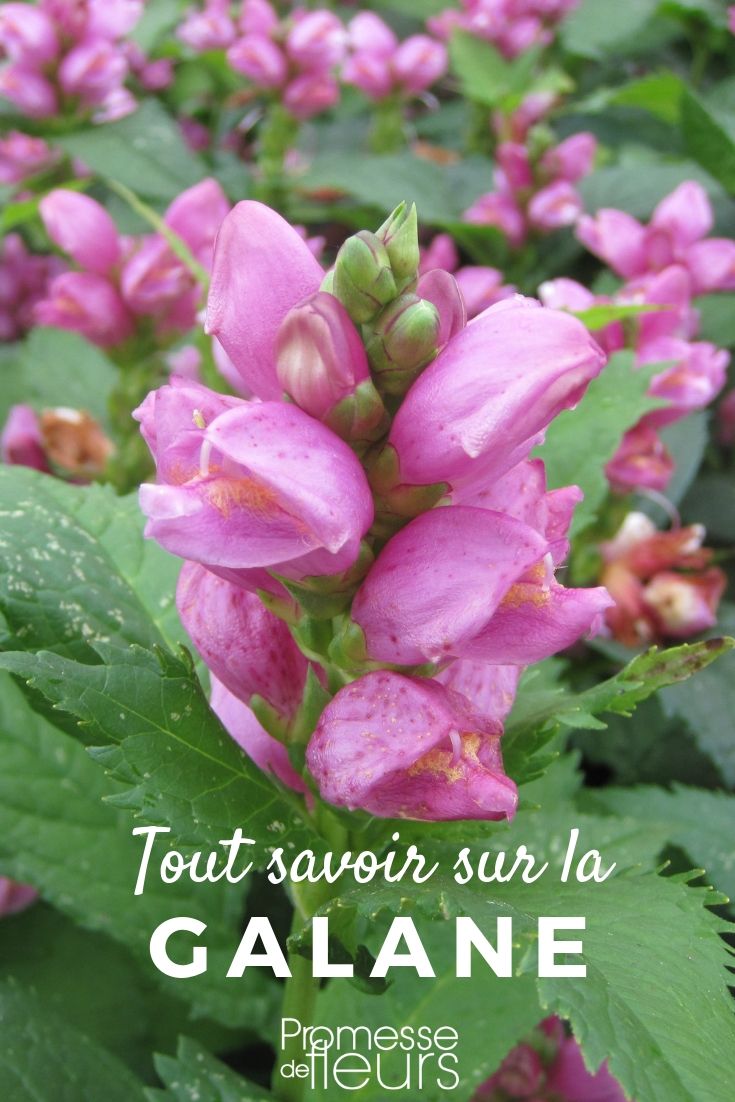































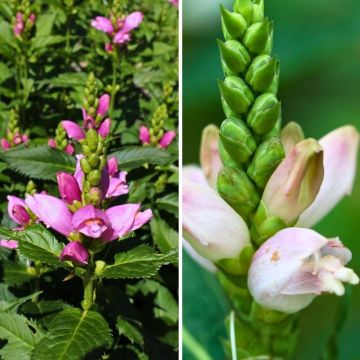




Comments